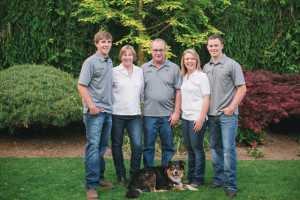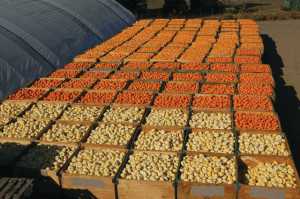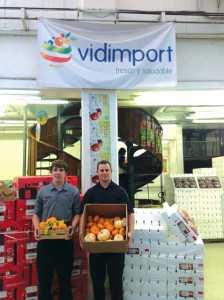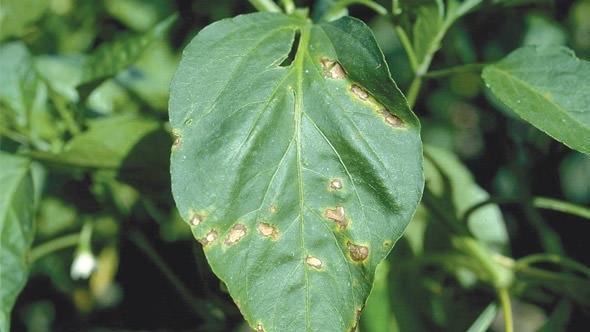Mini Pumpkin Entrepreneurs Expand Globally

The Wells family, (L-R) Darren, Diane, Dan, Stephanie (Dylan’s wife), Dylan, (and dog Tex,) has been successful with their mini pumpkin business.
Photo Credit: Jay Eads
A lot of well-known companies got their start in the unlikeliest of places. Hewlett-Packard was born in a garage. Dell was hatched in a dorm room. And Autumn Harvest sprouted in the bed of a ‘65 Chevy pickup truck.
A dozen years ago, the Wells brothers of Hubbard, OR, got a valuable lesson from their parents, Dan and Diane Wells. Their parents owned a nursery — Dan once served as president of the Oregon Association of Nurseries — and had over-planted a garden with large pumpkins. Dan, eager to give the boys some real-life experience, filled the pickup’s bed with pumpkins and parked at the end of the driveway.
Dylan, then 12, and Darren, then 9, were in business, selling pumpkins at $5 apiece. The only problem was that school was back in session. So they cut a hole in the top of an old toolbox and asked that people pay them on the honor system. “We’d come home from school and check it out,” says Dylan Wells. “I wish it were that simple now.”
Niche: Mini-Pumpkins

Autumn Harvest has about 200 acres of cucurbits, including miniature pumpkins, decorative gourds, and winter squash.
Photo credit: Wells family
The boys’ success gave their father an idea. He thought there might be some demand for miniature pumpkins, and after doing some research — including sounding out area growers who agreed there was a market — Autumn Harvest was launched. Today they have about 200 acres of cucurbits, not only mini-pumpkins, but decorative gourds and winter squash as well.
“We sell 15 varieties of winter squash,” says Dylan, who serves as Autumn Harvest spokesman. “It helps us lengthen the season out into January.”
Initially they sold strictly wholesale, with about 40% of sales to grocery chains, 60% to produce distributors. But that changed about five years ago. They kept getting phone calls from people who wanted to decorate large spaces, such as for weddings (See “I Do, I Do”), and restaurants and hotels. “At Halloween a lot of hotel lobbies are completely decorated to the nines with ghost pumpkins and other things,” says Dylan.
They also established a website, www.autumnharvestpumpkins.com, where the family packs have proved popular. The 100-count packs, which sell for $125 with free shipping in the U.S., include such varieties as the most popular mini-pumpkin, Jack Be Little (Hollar Seeds), and Baby Boo (Seedway), a white pumpkin.
Dylan and Darren also fit the mold of the GenNext Grower: young people with a passion to produce high-quality specialty crops. (For more information about GenNext, go to http://GenNextGrowers.com.)
Eyeing Exports

Darren (left) and Dylan Wells focus on foreign markets with their mini pumpkins.
Photo credit: Wells family
More recently, the Wells have been focusing on markets in other countries, especially Mexico. They learned that the Japanese really treasure the small sizes of the Autumn Harvest varieties, and that a similar situation can be found in Mexico. “They’ve really started to pick up on this pumpkin thing,” says Dylan.
Once again they availed themselves of their parents’ deep roots in the Willamette Valley — as well as their parents’ vast network of contacts. They contacted the Oregon Department of Agriculture, which put them in touch with the Western United States Agricultural Trade Association (WUSATA). They have worked with International Trade Specialist David Anderson of the Washington State Department of Agriculture, who is aligned with WUSATA. (See “International Shipping: How To Begin.”)
WUSATA’s mission, which is funded through USDA’s Market Access Program funds, is to help increase U.S. exports. It’s a mission they take seriously, says Dylan. “If we had known about them earlier,” he says, “it would have helped us exponentially.”
The Wells have ventured down to Mexico with WUSATA four times. Each time the agency has set up meetings and provided translators. “We couldn’t have done it without them,” says Wells. “They take a huge planning burden off our company, and they know the market so well they can help you out during the meetings.”
Wells says he recommends WUSATA to any grower who asks him about exports. The agency not only makes putting an export program together possible, they can make some of the steps, such as traveling to meet buyers, absurdly easy. “All you have to do is just show up in the hotel lobby at 8 a.m.,” Wells says, “and they take you to your meeting.”
International Shipping: How To Begin
Western United States Agricultural Trade Association (WUSATA, www.wusata.org), which serves growers in 13 western states, is just one of four State Regional Trade Groups (SRTG) that assists them with the promotion of food and agricultural exports. WUSATA’s three counterpart SRTGs provide similar services for companies that are based outside of the WUSATA region.
The first step for growers, says International Trade Specialist David Anderson, is to go to the website of the SRTG that serves their region. For growers in the south, go to the Southern United States Trade Association (SUSTA): Southern Region (www.susta.org). Growers in the Northeast and Midwest have the following SRTGs’, respectively, Food Export USA-Northeast: Northeast Region, and Food Export Association of the Mid-West USA: Mid-Western Region. Both can be found at www.foodexport.org.
It’s best to start with someone from your home state, says Anderson, and each of those websites will provide contact information to home state officials. If you’re a small grower, don’t think you’re ineligible. Indeed, Anderson says the focus is on smaller growers. “Most growers are eligible to participate,” he emphasizes.
Anderson says one of the primary activities of WUSATA is to arrange for buyers from other countries to come to the U.S. to meet growers. For example, last summer he brought in a group of buyers from Mexico and Central America to visit growers in California and Washington. In the fall, another group of buyers from Mexico met with growers in Colorado and Idaho.
The buyers certainly aren’t limited to nearby countries, says Anderson. WUSATA works with buyers from all over the world. This past October, for example, four buyers from Japan visted Oregon and then went to New Orleans for the Produce Marketing Association’s annual trade show.
Bringing in buyers is just one of the activities the SRTGs perform, he says. Others include webinars on various markets as well as arranging visits to foreign trade shows and outbound trade missions.
I Do, I Do
Dylan Wells has learned how advantageous it can be to get publicity, not to mention how it can come from the unlikeliest of sources. He never envisioned he’d be getting calls from brides and wedding planners, but that’s exactly what happened five years ago.
“We got featured in a couple wedding magazines back East,” he recalls, “and the phone just went haywire.”
Each wedding planner had something in common — they wanted high-quality miniature pumpkins, and they wanted a lot of them. “We’ve got them in much higher quantities than what the grocery stores could sell,” he says.
These days, at least in the fall, he says he gets 20 email messages a week from brides wanting miniature pumpkins to decorate their autumn weddings.
Marketing sure has changed in the past decade, as he says that while Autumn Harvest gets some of the wedding decor business through word-of-mouth, most of it comes from a far less traditional means — Google searches.









